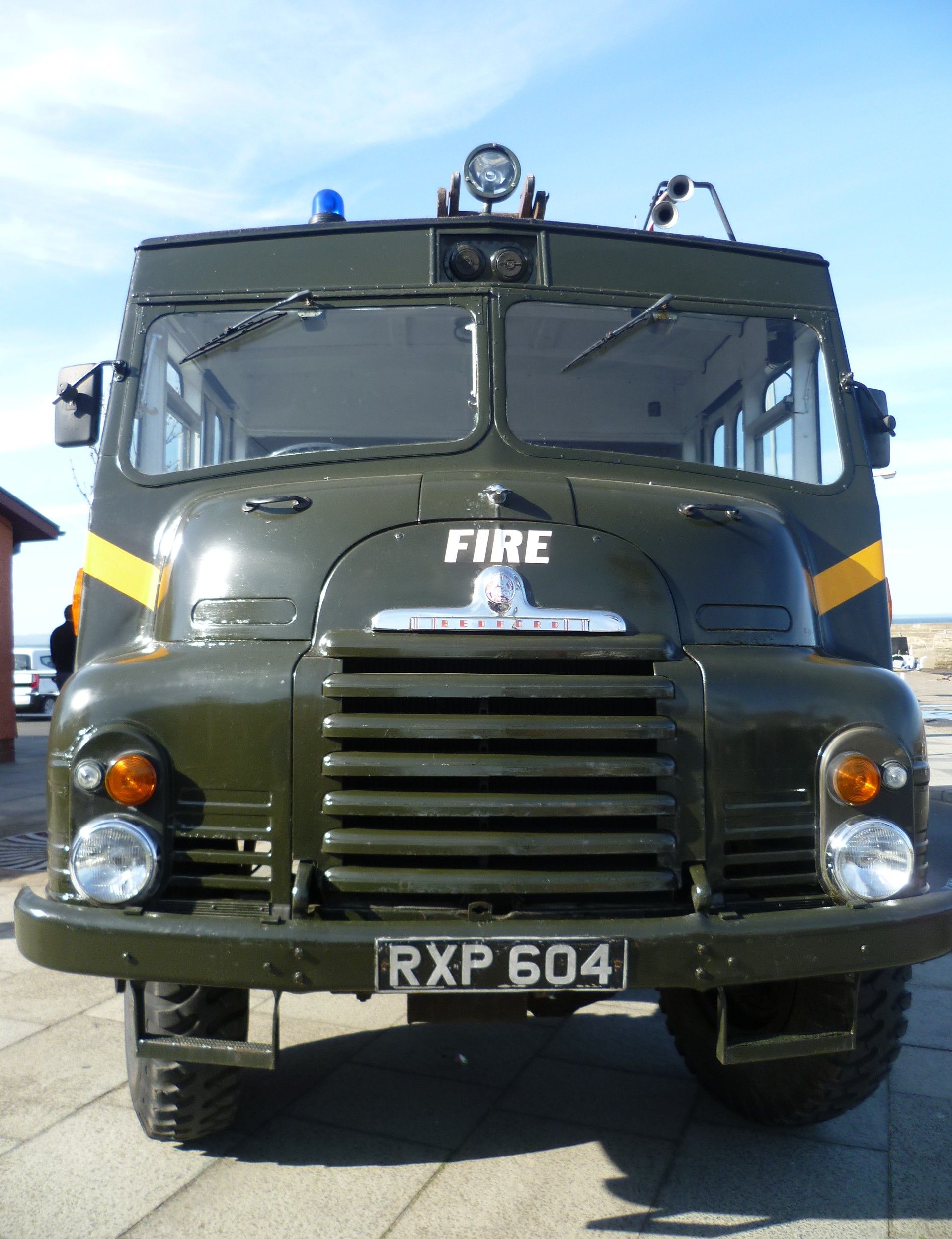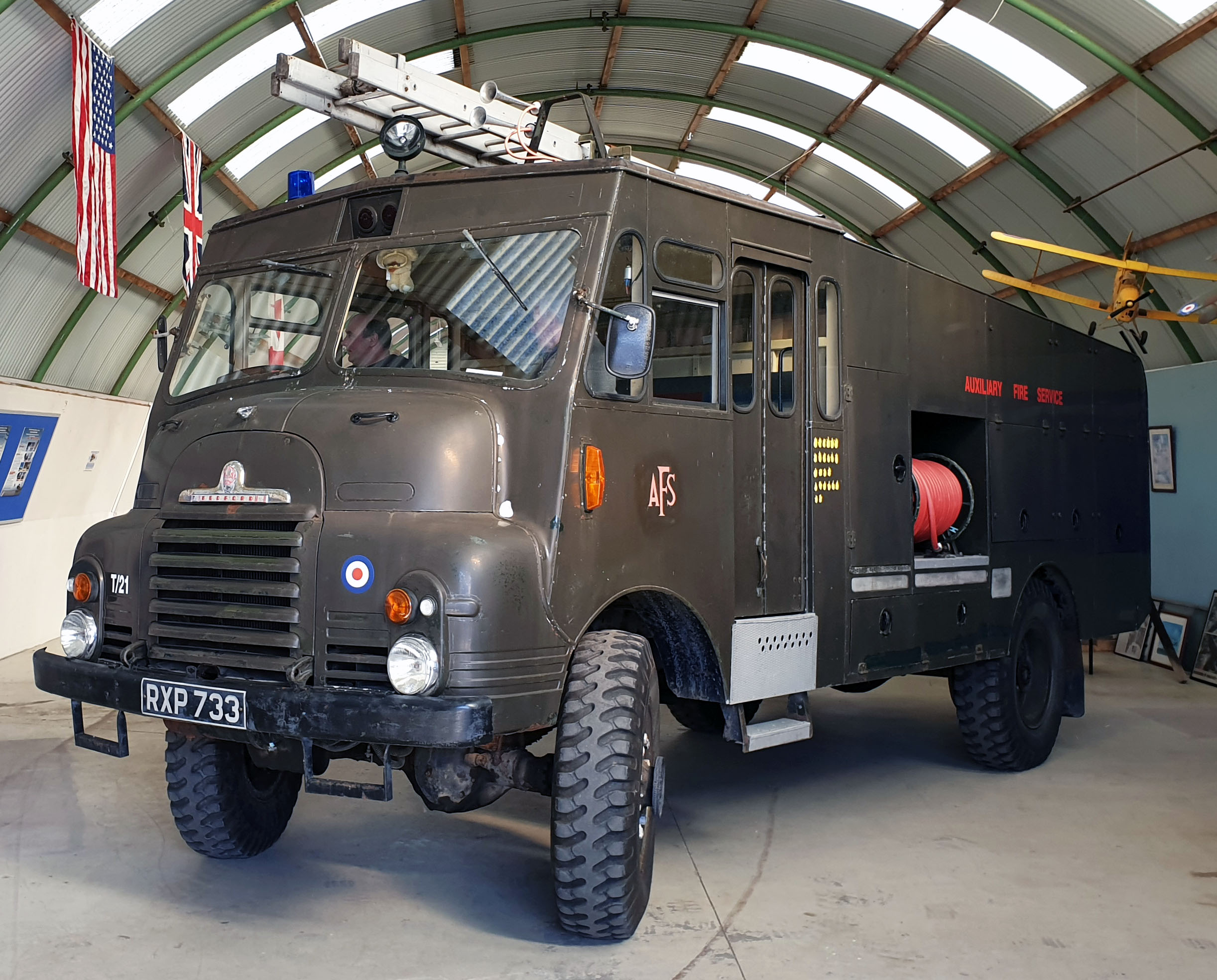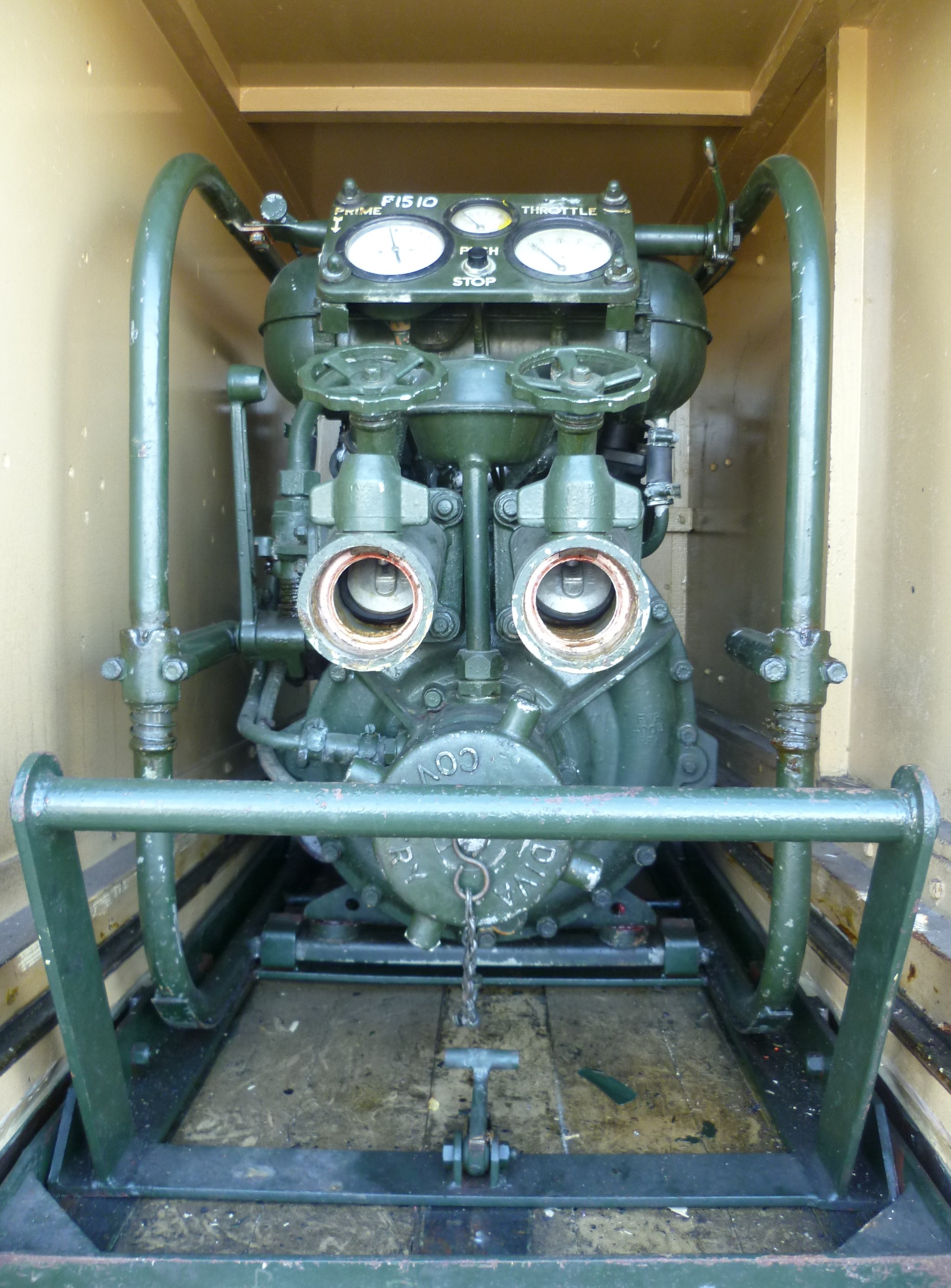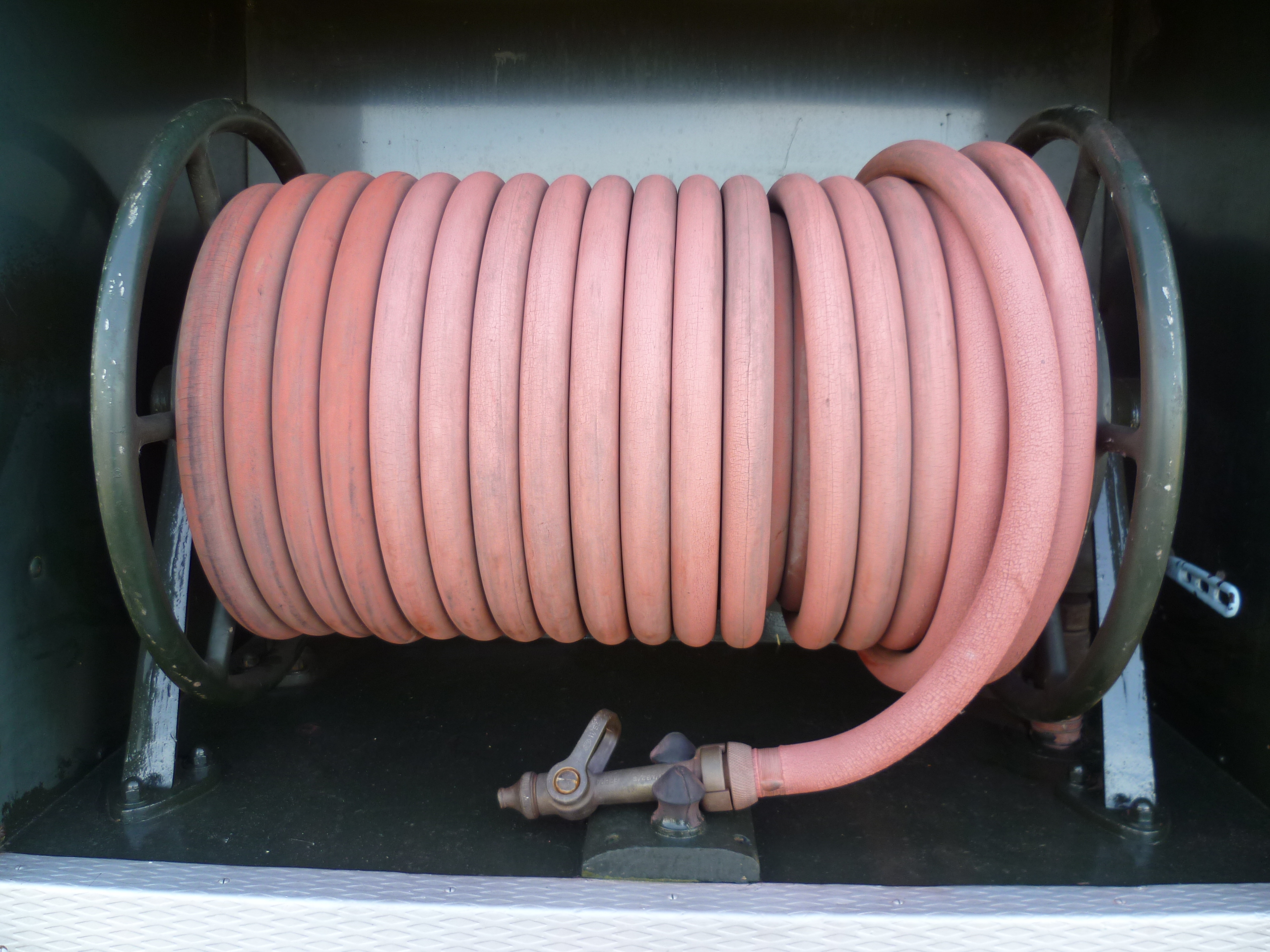Green Goddess on:
[Wikipedia]
[Google]
[Amazon]
The Green Goddess is the colloquial name for the RLHZ Self Propelled Pump manufactured by
 Prior to disbandment, the AFS used the Green Goddess extensively in support of the local fire services throughout the UK. They provided additional water delivery and firefighting capability at times when the regular fire brigades had a major incident to contain. The ability to relay large quantities of water over considerable distances was invaluable in some more remote locations, or where the incident required more water than local water systems could provide. Most UK boroughs had an Auxiliary Fire Service detachment housed alongside the regular brigade equipment.
After 1968, the vehicles were mothballed, but occasionally used by the Armed Forces to provide fire cover in a number of fire strikes, notably in 1977 and 2002 (see
Prior to disbandment, the AFS used the Green Goddess extensively in support of the local fire services throughout the UK. They provided additional water delivery and firefighting capability at times when the regular fire brigades had a major incident to contain. The ability to relay large quantities of water over considerable distances was invaluable in some more remote locations, or where the incident required more water than local water systems could provide. Most UK boroughs had an Auxiliary Fire Service detachment housed alongside the regular brigade equipment.
After 1968, the vehicles were mothballed, but occasionally used by the Armed Forces to provide fire cover in a number of fire strikes, notably in 1977 and 2002 (see

 In March 2004, the British Government announced that it was conducting a test sale of forty of its remaining fleet of more than nine hundred vehicles, and that it was planning to dispose of the remainder. The sale of the fleet was completed, and most of the vehicles were sold to fire brigades in developing countries, mostly in Africa. Some were donated to museums, including the prototype which was placed in the Museum of RAF Firefighting. Others are in the
In March 2004, the British Government announced that it was conducting a test sale of forty of its remaining fleet of more than nine hundred vehicles, and that it was planning to dispose of the remainder. The sale of the fleet was completed, and most of the vehicles were sold to fire brigades in developing countries, mostly in Africa. Some were donated to museums, including the prototype which was placed in the Museum of RAF Firefighting. Others are in the

 Unlike modern engines they have no radio, no cutting equipment, no power steering and only a single
Unlike modern engines they have no radio, no cutting equipment, no power steering and only a single
Bedford Vehicles
Bedford Vehicles, usually shortened to just Bedford, was a brand of vehicle manufactured by Vauxhall Motors, then a subsidiary of multinational corporation General Motors. Established in April 1931, Bedford Vehicles was set up to build comme ...
, a fire engine
A fire engine (also known in some places as a fire truck or fire lorry) is a road vehicle (usually a truck) that functions as a firefighting apparatus. The primary purposes of a fire engine include transporting firefighters and water to an i ...
used originally by the Auxiliary Fire Service
The Auxiliary Fire Service (AFS) was first formed in 1938 in Great Britain as part of the Civil Defence Service. Its role was to supplement the work of brigades at local level. The Auxiliary Fire Service and the local brigades were superseded i ...
(AFS), and latterly held in reserve by the Home Office until 2004, and available when required to deal with exceptional events, including being operated by the British Armed Forces
The British Armed Forces, also known as His Majesty's Armed Forces, are the military forces responsible for the defence of the United Kingdom, its Overseas Territories and the Crown Dependencies. They also promote the UK's wider interests, s ...
during fire-fighters’ strikes (1977 and 2002
File:2002 Events Collage.png, From left, clockwise: The 2002 Winter Olympics are held in Salt Lake City; Queen Elizabeth The Queen Mother and her daughter Princess Margaret, Countess of Snowdon die; East Timor gains East Timor independence, indepe ...
). These green-painted vehicles were built between 1953 and 1956 for the AFS. The design was based on a Bedford RL
The Bedford RL was the British military's main medium lorry, built by Bedford from the mid-1950s until the late 1960s. The lorry was based on the civilian Bedford S type, first introduced in 1950. They superseded the Bedford QL, and were in tur ...
series British military truck.
Auxiliary Fire Service
TheAuxiliary Fire Service
The Auxiliary Fire Service (AFS) was first formed in 1938 in Great Britain as part of the Civil Defence Service. Its role was to supplement the work of brigades at local level. The Auxiliary Fire Service and the local brigades were superseded i ...
was established as part of civil defence
Civil defense ( en, region=gb, civil defence) or civil protection is an effort to protect the citizens of a state (generally non-combatants) from man-made and natural disasters. It uses the principles of emergency operations: prevention, mit ...
preparations after World War II
World War II or the Second World War, often abbreviated as WWII or WW2, was a world war that lasted from 1939 to 1945. It involved the vast majority of the world's countries—including all of the great powers—forming two opposin ...
, and subsequent events such as the Soviet Union
The Soviet Union,. officially the Union of Soviet Socialist Republics. (USSR),. was a transcontinental country that spanned much of Eurasia from 1922 to 1991. A flagship communist state, it was nominally a federal union of fifteen national ...
detonating an atomic bomb
A nuclear weapon is an explosive device that derives its destructive force from nuclear reactions, either fission (fission bomb) or a combination of fission and fusion reactions (thermonuclear bomb), producing a nuclear explosion. Both bomb ...
made their presence supporting civilians as part of Britain's civil defence an important role. It was thought that a nuclear attack
Nuclear warfare, also known as atomic warfare, is a theoretical military conflict or prepared political strategy that deploys nuclear weaponry. Nuclear weapons are weapons of mass destruction; in contrast to conventional warfare, nuclear wa ...
on Britain
Britain most often refers to:
* The United Kingdom, a sovereign state in Europe comprising the island of Great Britain, the north-eastern part of the island of Ireland and many smaller islands
* Great Britain, the largest island in the United King ...
would cause a large number of fires, which would overwhelm the ordinary fire service, so a large stock of basic fire engines was ordered to form a reserve capacity. They were in continuous use by the AFS, until disbandment in 1968 by the Harold Wilson
James Harold Wilson, Baron Wilson of Rievaulx, (11 March 1916 – 24 May 1995) was a British politician who served as Prime Minister of the United Kingdom twice, from October 1964 to June 1970, and again from March 1974 to April 1976. He ...
Government.
The Green Goddess machines were not primarily fire engines (AFS members referred to them as "appliances"); they are more correctly titled "self-propelled pumps", with some being two-wheel drive
Two-wheel-drive (2WD) denotes Motor vehicle, vehicles with a Powertrain, drivetrain that allows two wheels to be driven, and receive Engine power, power and torque from the engine, simultaneously.
Four-wheeled vehicles
For four-wheeled vehicles ( ...
(4×2), and others in four-wheel drive
Four-wheel drive, also called 4×4 ("four by four") or 4WD, refers to a two-axled vehicle drivetrain capable of providing torque to all of its wheels simultaneously. It may be full-time or on-demand, and is typically linked via a transfer case ...
(4×4) form. Their main role was to pump huge quantities of water from lakes, rivers, canals and other sources into cities hit by a nuclear attack. The machines could be used in a relay system over a number of miles, with Green Goddesses at regular intervals to boost the water pressure. Firefighting was a secondary role.
Operational use
 Prior to disbandment, the AFS used the Green Goddess extensively in support of the local fire services throughout the UK. They provided additional water delivery and firefighting capability at times when the regular fire brigades had a major incident to contain. The ability to relay large quantities of water over considerable distances was invaluable in some more remote locations, or where the incident required more water than local water systems could provide. Most UK boroughs had an Auxiliary Fire Service detachment housed alongside the regular brigade equipment.
After 1968, the vehicles were mothballed, but occasionally used by the Armed Forces to provide fire cover in a number of fire strikes, notably in 1977 and 2002 (see
Prior to disbandment, the AFS used the Green Goddess extensively in support of the local fire services throughout the UK. They provided additional water delivery and firefighting capability at times when the regular fire brigades had a major incident to contain. The ability to relay large quantities of water over considerable distances was invaluable in some more remote locations, or where the incident required more water than local water systems could provide. Most UK boroughs had an Auxiliary Fire Service detachment housed alongside the regular brigade equipment.
After 1968, the vehicles were mothballed, but occasionally used by the Armed Forces to provide fire cover in a number of fire strikes, notably in 1977 and 2002 (see 2002-2003 UK firefighter dispute
The 2002–2003 UK firefighter dispute was a period of nationwide strike action which began when the Fire Brigades Union (FBU) voted to strike in an attempt to secure better salaries. The FBU demanded a 39 percent increase in pay, which would ha ...
). They were also deployed to pump water in floods and droughts. They were well maintained in storage, and regularly road tested. There was a less significant strike by firefighters in the Winter of Discontent
The Winter of Discontent was the period between November 1978 and February 1979 in the United Kingdom characterised by widespread strikes by private, and later public, sector trade unions demanding pay rises greater than the limits Prime Minis ...
(late 1978 and early 1979), where once again the Green Goddesses were drafted in to cover; it is largely forgotten by many as it occurred at a time when a significant percentage of public sector workers were on strike.
The role of Green Goddesses was superseded by new contingency arrangements. The Fire and Rescue Services Act 2004
The Fire and Rescue Services Act 2004 (c 21), sometimes abbreviated as FRSA 2004, is an Act of the Parliament of the United Kingdom.
It came into effect on 1 October 2004. It only applies to Great Britain and most provisions apply only in Engl ...
gave the government the power to instruct fire and rescue authorities to make their own vehicles available in the event of future industrial action. New Incident Response Unit
Incident may refer to:
* A property of a graph (discrete mathematics), graph in graph theory
* Incident (film), ''Incident'' (film), a 1948 film noir
* Incident (festival), a cultural festival of The National Institute of Technology in Surathkal, ...
s introduced after the September 11, 2001 attacks
The September 11 attacks, commonly known as 9/11, were four coordinated suicide terrorist attacks carried out by al-Qaeda against the United States on Tuesday, September 11, 2001. That morning, nineteen terrorists hijacked four commercial ...
offered high-power pumping ability among a range of other contingency functions.
Use in Ireland
35 units were bought by Irish Auxiliary Fire Service and allocated tocorporation
A corporation is an organization—usually a group of people or a company—authorized by the state to act as a single entity (a legal entity recognized by private and public law "born out of statute"; a legal person in legal context) and r ...
and county council fire services. 25 were bought new in 1961–1964 and ten more ex-British Government vehicles were bought second hand in 1971. Two more ex-British units were purchased by Dublin Civil Defence in 2005.
Disposal
 In March 2004, the British Government announced that it was conducting a test sale of forty of its remaining fleet of more than nine hundred vehicles, and that it was planning to dispose of the remainder. The sale of the fleet was completed, and most of the vehicles were sold to fire brigades in developing countries, mostly in Africa. Some were donated to museums, including the prototype which was placed in the Museum of RAF Firefighting. Others are in the
In March 2004, the British Government announced that it was conducting a test sale of forty of its remaining fleet of more than nine hundred vehicles, and that it was planning to dispose of the remainder. The sale of the fleet was completed, and most of the vehicles were sold to fire brigades in developing countries, mostly in Africa. Some were donated to museums, including the prototype which was placed in the Museum of RAF Firefighting. Others are in the National Emergency Services Museum
The National Emergency Services Museum is a museum in Sheffield, England. Opened on 8 May 1984 as the Sheffield Fire and Police Museum, it was given its present name on 1 January 2014.
Building
The museum is based at a former combined police ...
, National Museum of Scotland
The National Museum of Scotland in Edinburgh, Scotland, was formed in 2006 with the merger of the new Museum of Scotland, with collections relating to Scottish antiquities, culture and history, and the adjacent Royal Scottish Museum (opened in ...
, Kent Firefighting Museum, Leicester Fire Brigade Museum
Leicester ( ) is a city status in the United Kingdom, city, Unitary authorities of England, unitary authority and the county town of Leicestershire in the East Midlands of England. It is the largest settlement in the East Midlands.
The city l ...
, Yorkshire Air Museum
The Yorkshire Air Museum & Allied Air Forces Memorial is an aviation museum in Elvington, York on the site of the former RAF Elvington airfield, a Second World War RAF Bomber Command station. The museum was founded, and first opened to the pu ...
and Montrose Air Station Heritage Centre
The Montrose Air Station Heritage Centre is located to the North of Montrose, Angus, Scotland. Montrose has the distinction of having the first operational military airfield in Great Britain and the Heritage Centre is located on the former ...
. Some were purchased by vehicle restoration trusts and some are privately owned.
Technical specifications
ladder
A ladder is a vertical or inclined set of rungs or steps used for climbing or descending. There are two types: rigid ladders that are self-supporting or that may be leaned against a vertical surface such as a wall, and rollable ladders, such a ...
, and were relatively slow with a maximum speed of around , a comfortable cruising speed of , and they were sensitive on corners. But one advantage that some Green Goddesses enjoyed over most modern fire appliances was their four-wheel drive. Fuel consumption was between , depending on driving style and quantity of water carried. They also have less water capacity at in 4×2 form – on 4×4 versions – than a modern vehicle, and poorer stability due to a lack of baffle partitions in the water tank.
Some were later modified by the installation of flashing blue lamps and two-tone warning sirens, and alterations to the rear lamps, to bring them into line with then current practice on "regular" emergency appliances. Mechanically, they were designed to be robust and easy to maintain.
The Green Goddess carried a range of equipment from standard hose and branches, through a selection of nozzles to provide different flows and jet patterns, to Light Portable Pumps and Ceiling Arresters. They all carried a extension ladder
A ladder is a vertical or inclined set of rungs or steps used for climbing or descending. There are two types: rigid ladders that are self-supporting or that may be leaned against a vertical surface such as a wall, and rollable ladders, such a ...
, together with at least one scaling ladder. Some carried additional equipment, such as hook ladder
A hook ladder, also known as a pompier ladder (from the French ''pompier'' meaning firefighter) is a type of ladder that can be attached to a window sill or similar ledge by the use of a hooked extending bill with serrations on the underside. The ...
s, radios, large bolt cutter
A bolt cutter, sometimes called bolt cropper, is a tool used for cutting bolts, chains, padlocks, rebar and wire mesh. It typically has long handles and short blades, with compound hinges to maximize leverage and cutting force. A typical bolt ...
s, etc.
Pumps
The Sigmund F.N.5 main pump has a capacity of per minute ( on 4×4 versions). Normal fire hoses could be used either from the main pump, which had four outlets, or from normal fire hydrants for which an assortment of connecting branches were carried. In addition, the machines carried a smallCoventry Climax
Coventry Climax was a British forklift truck, fire pump, racing, and other specialty engine manufacturer.
History
Pre WW1
The company was started in 1903 as Lee Stroyer, but two years later, following the departure of Stroyer, it was relocat ...
pump, with its own petrol engine
A petrol engine (gasoline engine in American English) is an internal combustion engine designed to run on petrol (gasoline). Petrol engines can often be adapted to also run on fuels such as liquefied petroleum gas and ethanol blends (such as ''E ...
, which could also draw water from a river or other source, again feeding normal fire hoses, and which provided a separate and self-contained fire fighting capability. A water tank ( on 4×4) was installed, which fed small diameter hoses on each side of the vehicle to give an immediate "first aid" capacity to fight a fire while the main hoses were connected and brought into use. A stirrup pump was also carried, together with a full range of other suitable tools and equipment.
Crew
The vehicles were normally crewed by an officer in charge, who sat in the front passenger seat, a driver/pump operator, and four fire fighters seated on the crew bench. In the mid 1960s, some Territorial artillery regiments were earmarked for a water pumping role, partly because the six man gun crew matched the numbers on the pump units. Training methods and rotation of roles were common factors in gunnery and water pumping. Artillery regiments undertook a two-week course at Devizes in lieu of their normal annual gunnery training camp.See also
*Operation Fresco
The 2002–2003 UK firefighter dispute was a period of nationwide strike action which began when the Fire Brigades Union (FBU) voted to strike in an attempt to secure better salaries. The FBU demanded a 39 percent increase in pay, which would ha ...
* Military aid to the civil power
Aid to the Civil Power (ACP) or Military Aid to the Civil Power (MACP) is the use of the armed forces in support of the civil authorities of a state. Different countries have varying policies regarding the relationship between their military and c ...
References
External links
* *{{YouTube, id=Yo9WvwDroJc, title=Green Goddess TNT truckcare film PGW160 - Film discussing how to maintain a Green Goddess fire engine dating from the period they were in British Service. Fire service vehicles Bedford vehicles